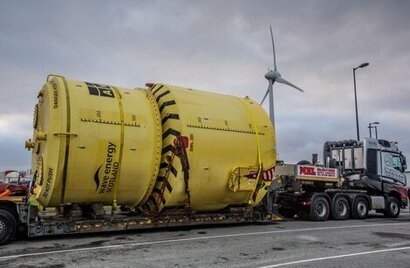
The 16 kW Archimedes Waveswing arrived at Hatston Pier, Kirkwall on Tuesday evening, 25 January 2022, before being transported to Copland’s Dock in Stromness where it will be readied for deployment at EMEC’s Scapa Flow test site in February.
Weighing in at 50 tons, the seven-metre high, four-metre diameter device travelled to Orkney by ferry following a period of dry testing undertaken by the AWS engineering team at Muir of Ord.
When deployed, the Archimedes Waveswing is moored to the seabed and sits below the surface of the sea, reacting to changes in pressure caused by passing waves. It is moored on a single tension tether. The subsea location and ability to winch low in the water column enables extreme storm loadings to be avoided so that the device can continue to operate in rough sea conditions. The Waveswing is designed to react to long ocean swell waves as well as short, wind-driven seas, for high energy capture.
The £3.4 million prototype project has been funded by Wave Energy Scotland (WES) as part of the Novel Wave Energy Converter development programme. The demonstration at EMEC is also supported by the Interreg North-West Europe’s Ocean DEMO project.
“This is another major step forward in the development programme, underlining our confidence that the Waveswing really is the best prospect for practical, affordable wave power” said Simon Grey, CEO of AWS Ocean Energy. “The whole team at AWS is looking forward to getting our at-sea testing programme underway at EMEC. Our current Waveswing design focusses on remote power applications such as powering subsea oilfield assets and oceanographic monitoring, however the device is suitable for integration into submerged platforms and can be scaled to over 500 kW per unit. AWS expect to develop platforms hosting up to 20 units with a potential capacity of 10 MW per platform. The exciting thing about Waveswing is that it’s genuinely scalable and practical to integrate into a multi-absorber platform. Achieving power outputs comparable with offshore wind units is critical to driving down the cost of energy and ensuring that operation and maintenance is practicable in the hostile marine environment.”
Tim Hurst, Managing Director of WES, added that the sea trials of the AWS Waveswing device represent the culmination of Wave Energy Scotland’s Novel Wave Energy Converter Programme and that the design offers a number of attractive innovations for a commercial market.
The Waveswing development programme has been supported by a strong, predominantly Scottish team of subcontractors including 4c Engineering and Quoceant on design, Sequentec on supply of the control system, Malin Marine for the main build and assembly work, and JGC Engineering for fabrication of the anchor frame. International subcontractors include Trelleborg for supply of the rolling seal and SRP Subsea for supply of the Rocksteady mooring connector. Marine operations for deployment of the device will be carried out by Stromness-based Green Marine.
For additional information:

